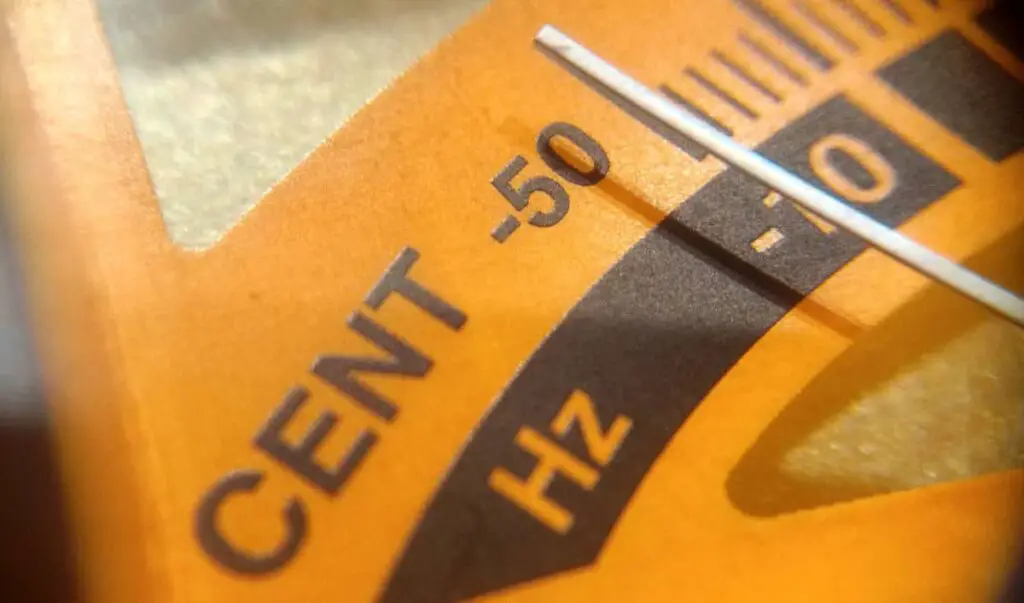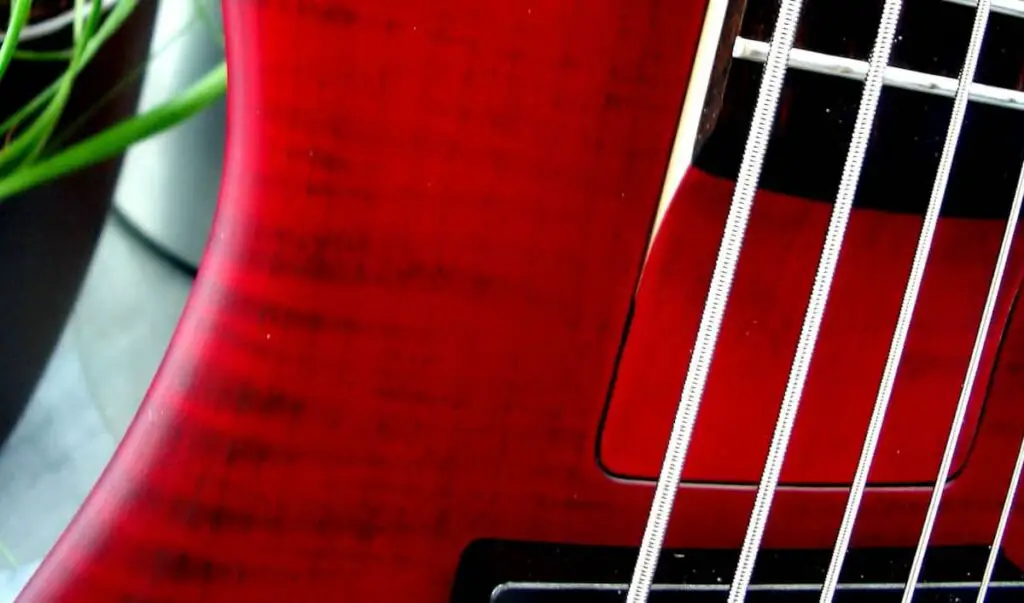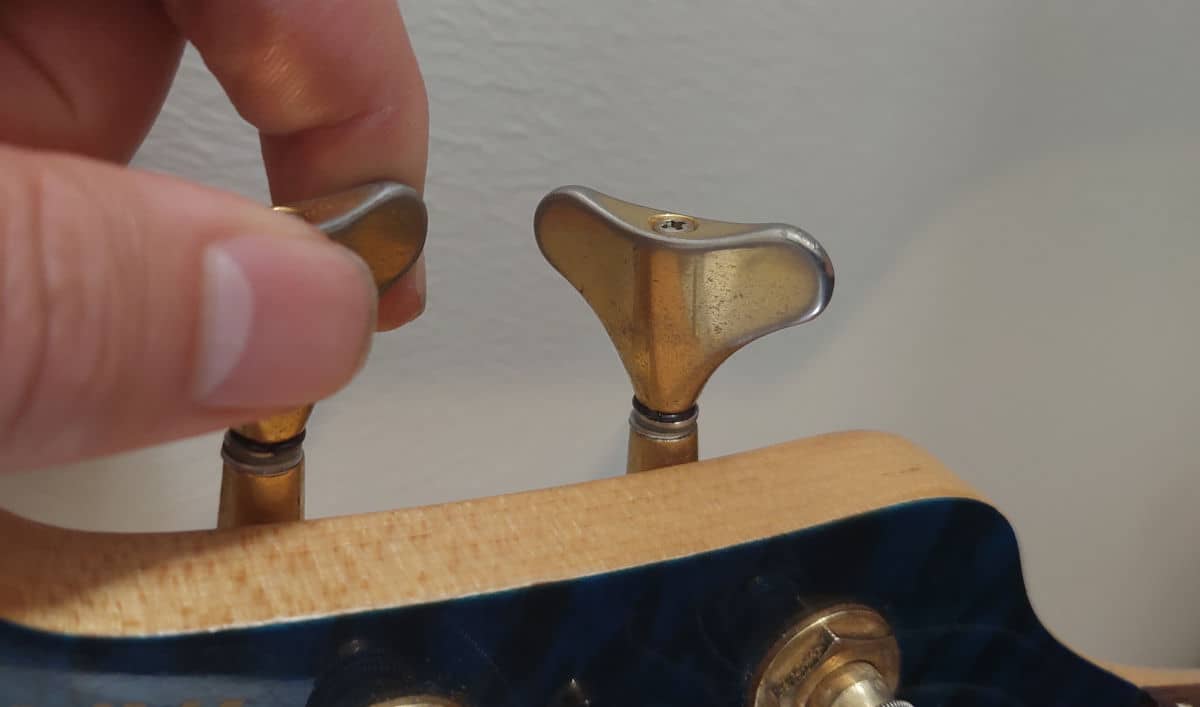This post contains affiliate links
At first glance, switching tunings on your bass can seem intimidating. Now notes have to be played at different spots on the fretboard, and the change in string tension affects your playing. Luckily, playing in D standard tuning on the bass can be approached similarly to E standard, which you are most likely familiar with.
After playing in various metal bands I have tuned my bass down to every tuning under the sun. D standard, in particular, is a tuning that can help you achieve a heavier sound without having to complicate things too much.
But how do you tune down to DGCF, and what should you be mindful of when doing so? Should you tune your bass to D standard instead of drop D, and why do bands elect to use D standard over other tunings?
This article will answer all of these questions and more. After reading it, you will know how to tune your bass down to D standard, why and when you should do it, and how to avoid the common mistakes people make when doing so.
What is D standard tuning on bass?
In the D standard tuning, the strings on a 4-string bass are tuned to D-G-C-F. 5-string basses are generally tuned A-D-G-C-F, or occasionally D-G-C-F-Bb. Either way, the strings are tuned down exactly one step lower than in E standard.
Bass guitars are most commonly tuned in E Standard. This is the familiar E-A-D-G tuning where strings are perfect fourths apart. In all standard tunings on the bass, strings are tuned perfect fourths apart in the same manner.
Thus, you can still apply all the knowledge and muscle memory of finger positions you have from playing in E standard. All you have to be mindful of is that you are playing in a different key.
Bands elect to use D standard over E standard for several reasons. Here are the most common ones:
- Heavier sound – Playing at deeper frequencies makes it easier for bands to sound heavier. Thus, tuning down instruments is the norm in metal, and it’s common in many genres of rock as well.
- Uniqueness – Due to how common E standard is, there are countless songs that are written in E and A. Playing in D standard pushes bands to write songs in D or G instead. This gives bands a more distinct sound and assists in creating original music.
- Accommodating the vocalist – Some vocalists have an unfit vocal range for songs that are in E standard. Generally, this is because the vocalist has a deep voice. Tuning to D standard can thus make it easier for the vocalist to reach every note easier, and showcase a stronger part of their range.

How do I tune my bass to D standard?
Your bass is tuned to D standard by tuning every string one whole step down from E standard to D-G-C-F. This can be done by ear the same way you would tune to E-standard by using a different instrument, by ear, or with a tuner.
For a quick and easy way to tune to D standard, use the tuner below. Play the sound clips and tune your strings to the same pitch as you hear, going from the thickest string, up to the thinnest:
D (Thickest string):
G:
C:
F:
Bb (for 5-strings):
If you are struggling to hear the pitch correctly, you can use an online tuner with a microphone. It will show you when your strings are exactly on pitch.
Due to bass frequencies being low, your microphone might struggle to pick up the lowest notes. If this happens, play the string you are trying to tune at the 12th fret instead of open.
There are also some other things you need to be mindful of when tuning down a bass guitar. This is especially true if you intend for your bass to stay permanently tuned in D standard:
- String change – I recommend switching to a thicker set of strings when tuning down to D standard. Playing with strings intended for E standard will result in a thinner tone when your strings are tuned DGCF. In turn, prevents you from getting a powerful and deep tone. More on string choice below.
- Neck relief – Switching to a different string gauge and tuning can impact the neck relief on your bass. If this happens, this can be fixed with a truss rod adjustment and will not damage your instrument.
- Staying in tune – If your bass is accustomed to being tuned in E standard, it will go out of tune fast when you switch to D standard. This will be less and less noticeable in time once the neck and strings on your best adjust to the new tuning.
- Higher action – The action on your bass is likely to get higher when tuning down to D standard. How much the action increases greatly varies on the bass and strings, but it will generally impact the tone and playability of your instrument to some extent.
What bands use D standard tuning?
D standard tuning has been used by artists in various genres. However, it is most commonly used by metal bands.
Heavier bands often switch between tunings, so how much any single band uses D standard varies greatly. Some bands only tune to D on rare occasions, while others have used it for the majority of their discography.
D standard is a common tuning in symphonic metal, but you will find bands using it in everything from death metal to hard rock. Here is a list of bands that use the tuning, and a couple of their songs that are played in D standard:
| Band | D standard tuning usage | Notable songs in D standard |
| Metallica | Occasional | Sad But True, The Thing That Should Not Be |
| Death | Main tuning | Voice of the soul, Spirit Crusher |
| Mastodon | Commonly used | Blood and thunder, Colony of Birchmen |
| Mötley Crüe | Main tuning | Dr. Feelgood, Kickstart my heart |
| Sepultura | Commonly used | Nomad, Territory |
| Nightwish | Main tuning post-Century Child | Amaranth, Bye Bye Beautiful |
| Wintersun | Commonly used | Sadness and hate, Sleeping stars |
| Gojira | Commonly used | Backbone, Stranded |
| All That Remains | Main tuning until Overcome | This Calling, Six |
| Symphony X | Main tuning | The Odyssey, Paradise lost |
Bass strings for D standard
For D standard tuning, bassists generally prefer heavy-gauge bass strings in the 0.110-0.050 range. Heavy gauge strings are more suited for a powerful, rumbling sound and will not feel too loose when tuning down. For slapping and faster melodic playing, medium gauge strings are a great alternative.
The standard gauge for strings that are designed for E standard is 50-105.
While it is perfectly possible to tune down to D standard while using these strings, you will run into some issues if you try.
First and foremost, this will lead to lower string tension. As a result, you are more likely to experience fret buzz. When the strings are too loose it also impacts the tone of your bass and can result in a sound that is wobbly and less powerful. Doing slides also tends to become awkward and difficult to do in a smooth manner.
Thus, you want to use a set of heavy-gauge bass strings. I`ve gotten a great sound in D standard with 50-110 strings. Alternatively, you can also use 55-110.
If you intend to play in D standard regularly, I recommend getting this 50-75-90-110 set by D`Addario (amazon link). The set will help you achieve a powerful deep tone and it’s less likely to cause fret buzz than a 50-105 set.

D standard tuning for 5-string basses
D standard tuning for 5-string bass with a low sting is A-D-G-C-F. When adding a high string rather than a low one the bass should be tuned D-G-C-F-Bb.
The reason many bassists pick up a 5-string in the first place is that they need more deep range. Thus, 5-string bassists that play in D standard generally tune to A-D-G-C-F.
The alternative is D-G-C-F-Bb where an additional high string is used rather than a low one. However, the extra high range is generally redundant, unless you have an incredibly melodic playstyle.
5-string basses in D standard with an additional low string have an additional perfect fifth of deep range compared to 4-strings in E standard. Thus it allows bassists to play as deep as A standard and drop A. Thus, it is a great choice in bands where instruments are tuned tremendously deep, or in bands that switch between tunings often.
Related reading: Do you need a 5-string bass for metal?
D standard vs drop D tuning for bass
In D standard every string is tuned down a whole step, whereas in drop D only the deepest string is tuned a whole step down. The strings are thus tuned D-A-D-G in drop D on a 4-string bass.
Drop tunings are convenient for guitarists, as they make power chords easier to play. This is because the 2 deepest strings can be used to play power chords by using 1 finger rather than two.

On the bass D, standard and drop D give you the same deep range. Drop D allows for one whole step higher range, which will rarely matter for most bassists.
The advantage of playing in D standard is that if you have developed muscle memory and an understanding of the fretboard while playing in E standard, this can be applied in D standard too. You have barely had to adjust to playing in a different tuning, and playing will feel intuitive and fluid.
The advantage of drop D is that you will be more in synch with guitar players that are playing in drop D. Playing in the same tuning allows you to play riffs the way the guitar players are doing without adjusting the riff for a different tuning. Riffs will generally be harder to play in D standard when they were written in Drop D, especially if they utilize the open D string a lot.

Is it bad to change tunings a lot?
Changing tunings a lot will cause metal fatigue to your strings over time, which results in you having to change them somewhat more often. Switching regularly to common standard and drop tunings such as D and C does not damage your instrument.
Changing tunings a lot will also wear out the cores on the wound windings of your strings. It takes time to see the effects of this, but constant switching between tunings will require more frequent string changes.
An uncommon way of solving this is to keep your bass in D standard and use a capo on your second fret for when you are going to play in E standard. You can apply the same trick in C standard and use a capo on the second fret for D and on the fourth for E standard.
Also, songs that are written for E can often be played on a bass that’s tuned to D. A bass that’s tuned to C standard can also play most anything in D and E standard as well. Issues mainly occur when you need to play riffs that utilize open strings a lot, such as this one:

Ideally, it’s best to have separate basses for different tunings. Switching between tunings also means that your strings will not be of ideal thickness for every tuning, and your bass might require trust rod adjustments due to experiencing differences in neck relief.
If using two basses is not feasible, my recommendation is to tune your bass to the lowest tuning you need to play in. You can use this tuning to play in any key and tuning that is higher than it.
Bear in mind that some riffs that utilize open strings might become difficult to play. This will be especially true trying to play drop-tuning riffs in standard tuning.
Conclusion
Tuning your bass to D standard is a great way to get a deeper and heavier sound, without having to change the way you think about your fretboard.
When switching to DGCF you should invest in a thicker set of strings to avoid fret buzz and your strings becoming loose. You should also be mindful of the intonation, action, and string relief of your bass after tuning down.
D standard is mainly used by metal bands in various sub-genres. It has also been used by various artists, such as Lou Reed to avoid the cliche of playing too much in E and to accommodate a deeper vocal range.
Drop D and D standard tunings have the same deep reach on the bass. Which tuning is more suitable generally depends on what type of riffs the guitarists are playing and how they utilize the open low D string. While it is possible to tune a bass to D standard and the guitars to drop D, it is generally preferable for a band to play in the same tuning.
Changing tunings regularly is not the end of the world, but getting a separate bass for separate tunings is a preferable option. This will reduce wear on the strings and neck of your bass. With two basses you also don’t have to constantly be mindful of staying in tune, as strings go out of tune quicker when they are constantly tuned up and down.
Even though they tune down their basses and have a powerful tone, metal bassists can often be difficult to hear. If you have ever wondered why this is, I recommend reading my article on why you can’t hear the bass in metal songs. It will help you understand the role of bass in metal and why it rarely cuts through the mix.

